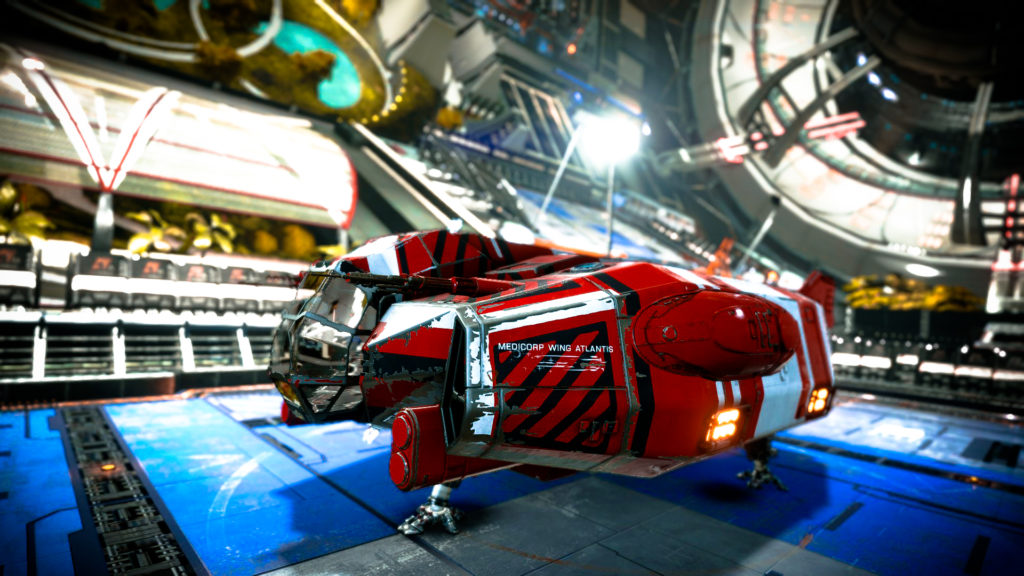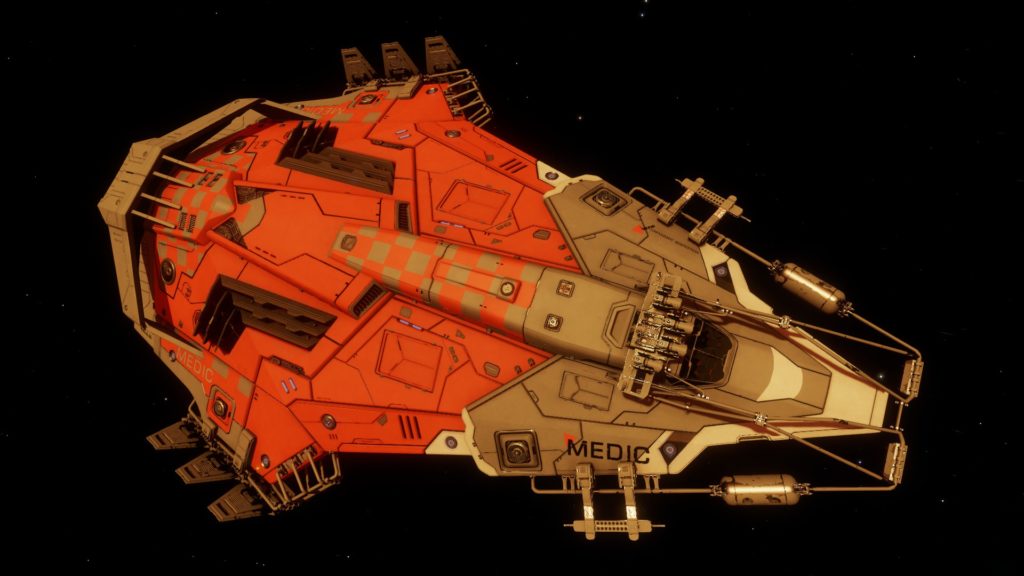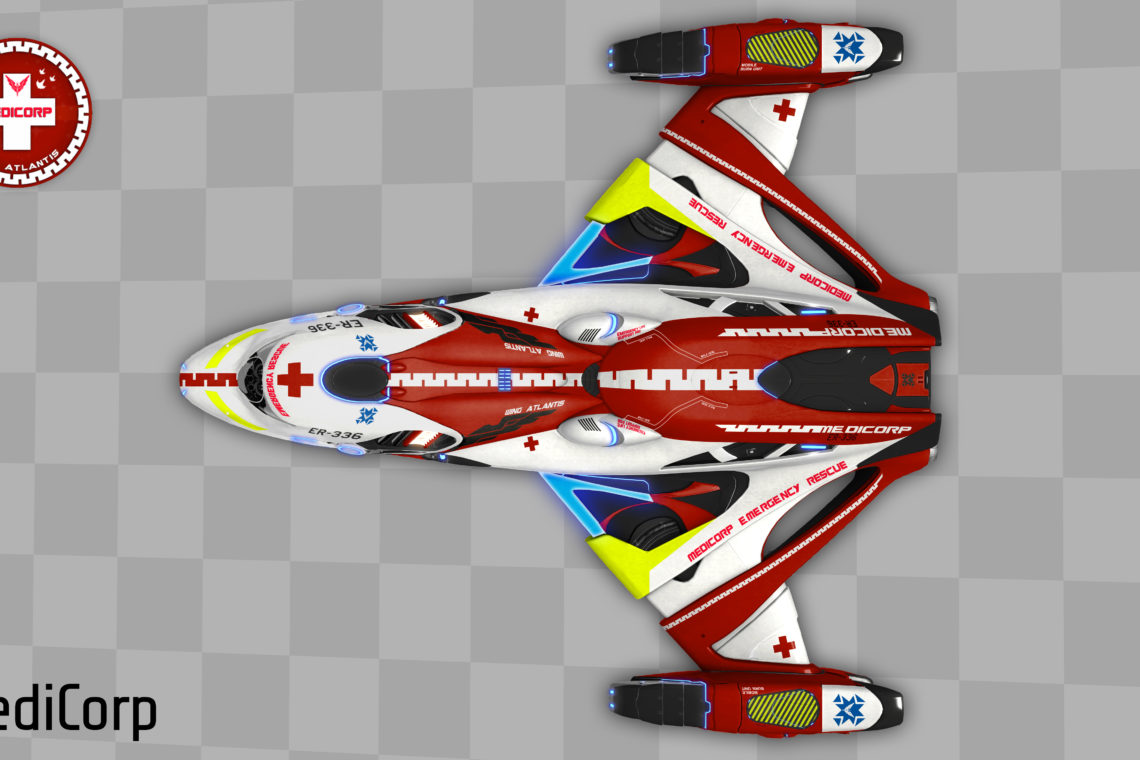MediCorp Ship Configuration Tips
MediCorp ships are subject to specific guidelines; for detailed rules, please refer to the designated page. Below, you will find suggestions for configuring your MediCorp ship, based on community proposals. These suggestions are not mandatory and are divided into two main categories: basic ambulances and evacuation ships for burning stations.
MediCorp Basic Ambulance Configuration:
Ambulance ships are fundamental for rescuers. They are designed for searching and rescuing pods, as well as for transporting medical supplies, emergency shelters, etc. Emphasis is placed on cargo capacity, recovery drones, and tract beams for pod retrieval from mega-ships.

The following ship configurations are merely suggestions, catering to various ship sizes within the game and are particularly suited for beginner to intermediate players:
Medevac Ships in Thargoid War Zones:

Since the Odyssey update 14 (November 29, 3308 – 2022), MediCorp has engaged in operations within Thargoid conflict zones, focusing on logistics, civilian evacuation, and pod missions. The unique demands of these zones necessitate specially outfitted ships, considering the high risk of interceptions and hyperdictions. Safety largely depends on speed, with ships capable of boosting over 400 m/s, ideally reaching speeds of 500 m/s or more, being preferred.
Evacuation missions are available in both INVASION and ALERT systems, with ALERT systems offering easier navigation due to fewer interceptions.
Interceptions
Thargoids conduct two types of interceptions: in supercruise and between systems (hyperdictions). While little can be done about hyperdictions, supercruise interceptions can be evaded with a “cold” ship that remains undetectable to Thargoids. Enhancing ship cooling, either through engineering or deploying heat sinks every 700 Sl, is advisable.
Updates on Thargoid Ships:
- Update 15: Introduced the Glaive, a fast Thargoid fighter targeting the FSD engine, complicating missions further.
- Update 16: Introduced the Scythe, another fighter-class ship designed for nacelle recovery.
Tips for Navigating Invaded Systems:
- Speed is crucial (>400 m/s recommended, >500 m/s ideally) as Thargoid interceptors match or exceed these speeds.
- A modified power distributor allows for quicker boosts.
- A large cargo hold and/or numerous economy cabins are beneficial.
- Minimize Guardian module usage.
- Protect your modules with reinforcement.
- Opt for a medium PAD due to numerous under-attack outposts.
- Shields can mitigate some damage and collisions in turbulent zones.
- Consider a field neutralizer for EMP waves (optional).
- You can equip an Electronic Countermeasure (ECM) to passively neutralize FSD disabling missiles or Thargoid drones attempting to hack your cargo hold. This utility has a range of 3 km and must be used with the HUD in “combat” mode.
While these are flexible suggestions, MediCorp favors the Python (configured for speed or stealth) and the Krait MKII (for its superior cargo capacity compared to the Phantom).
NOTE: Ships tagged with “ALERT” may not be ideal for missions in INVASION-status systems.
Titan Rescue Missions

Since October 3309 (2023), missions to retrieve bio-storage capsules captured by Titans have been feasible. These operations are notably intricate, demanding both experienced (advanced level) players and ships equipped specifically for the task. Titans are located at the center of corrosive clouds, making the surrounding environment exceedingly hostile. Successfully navigating to and engaging with a Titan requires completing several steps and equipping specific modules tailored to withstand these harsh conditions.
Caustic Environment Exploration and Reconnaissance Vessels (CERVs)
CERVs are specifically designed for missions within caustic environments (refer to the article for more details). These vessels can be customized for such tasks. For recovery missions, it is essential to equip the ship with a modified mining missile. MediCorp has regulated the use of this missile, and adherence to this regulation is mandatory: The use is regulated and temporary, representing the only exception regarding “weapons.” It is permitted solely within the specific context of these missions (outside of these Titan recovery missions, these missiles must be uninstalled). For more information on these missions, please refer to the dedicated section in our Gameplays (see MediCorp gameplays).
Fire Station Evacuation Ships

Evacuation vessels are deployed to stations engulfed in flames. They can serve a dual purpose: retrieving pods within the station and/or evacuating civilians. Depending on the vessel and the rescuer’s choice, priority may be given to either cargo space for pods or economy cabins for civilians (who are accommodated in economy cabins). Achieving a balance between the two is feasible. Due to the intense heat, heat sinks are necessary, as well as recovery drone controllers if the rescuer intends to retrieve pods.
The ship configurations below are merely suggestions and encompass nearly all ship sizes available in the game, primarily suitable for beginner to intermediate players.
